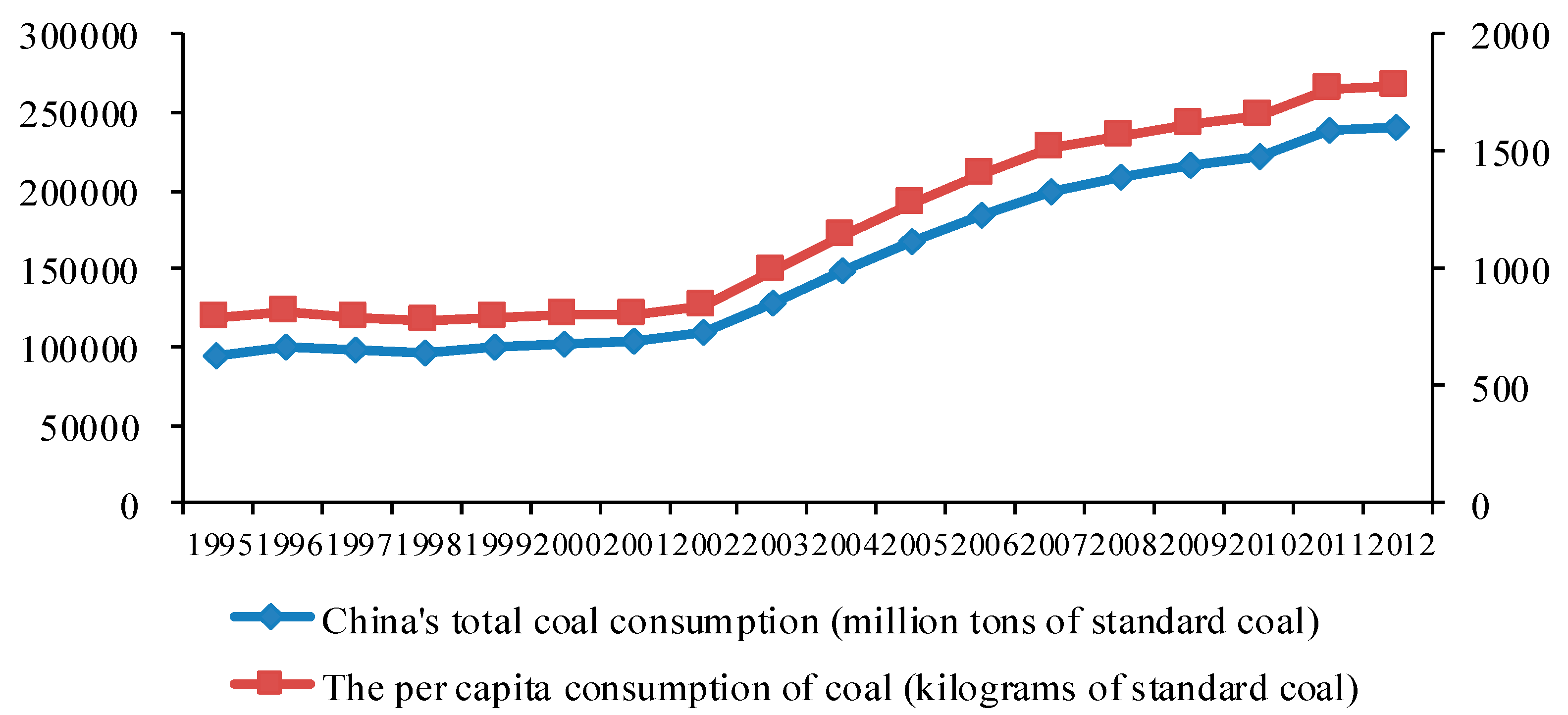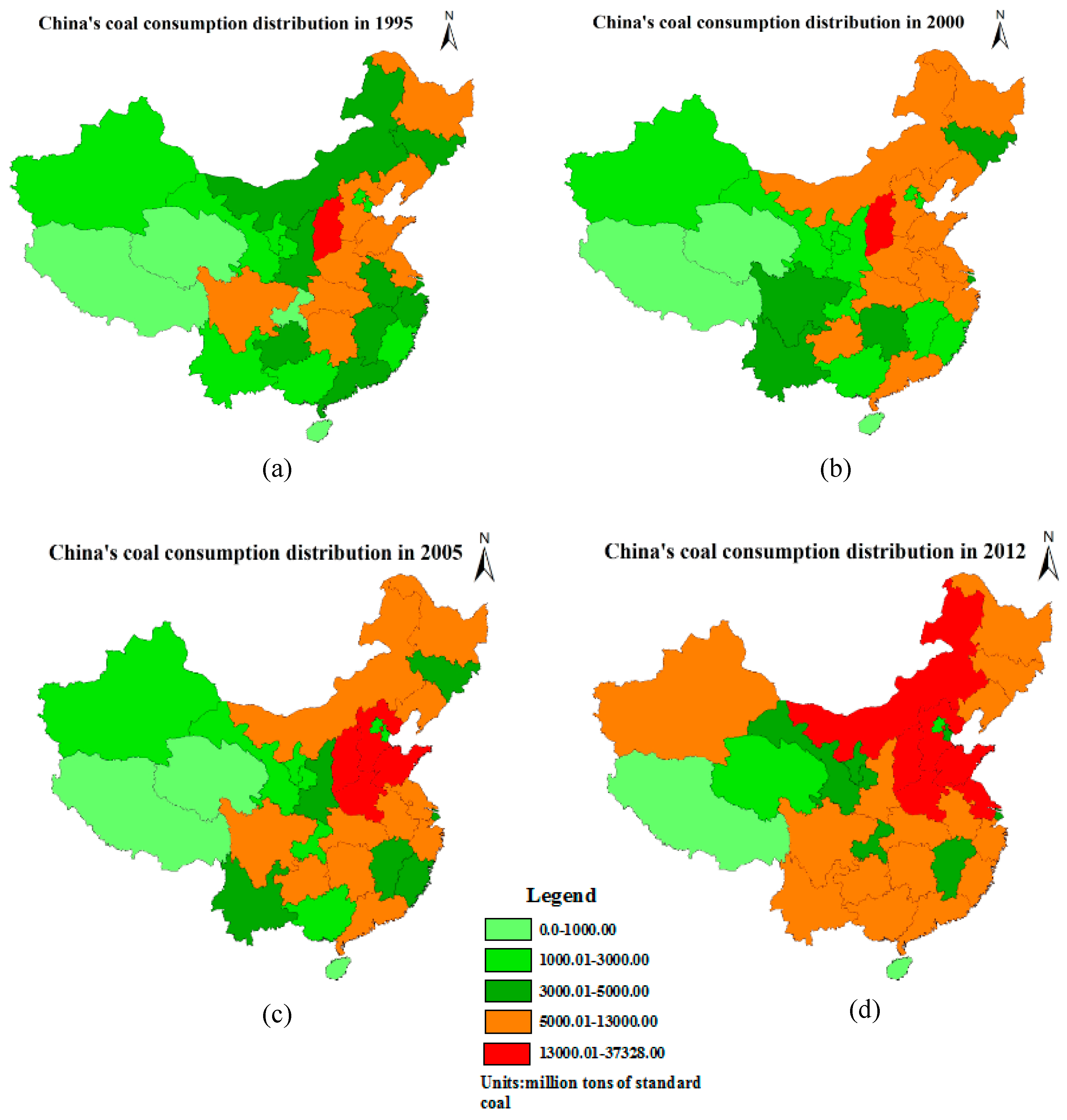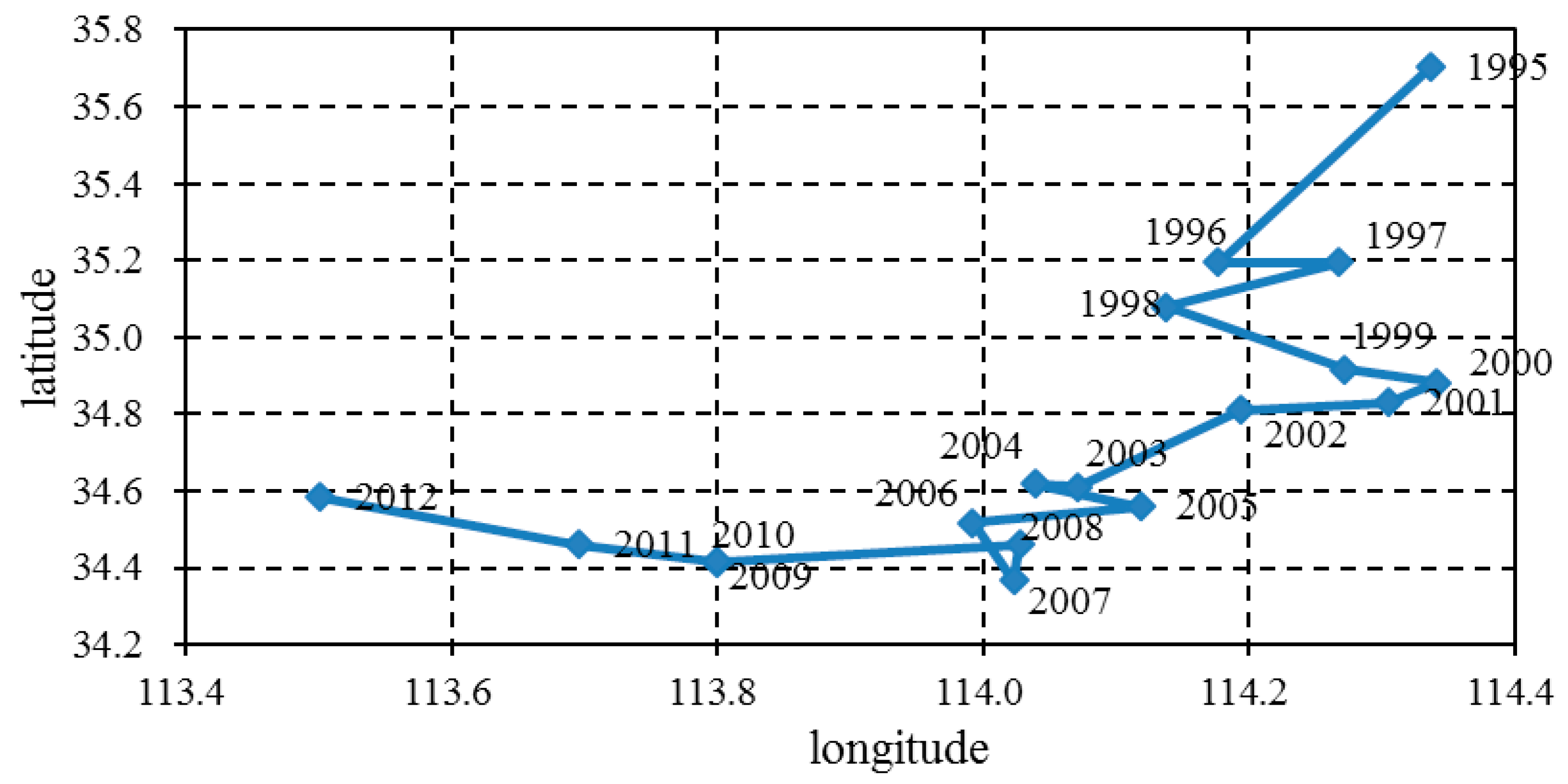Dynamic Factor Analysis of Trends in Temporal–Spatial Patterns of China’s Coal Consumption
Abstract
:1. Introduction
2. Materials and Methods
2.1. Methods of Spatial Analysis
2.2. Barycenter Model
2.3. Spatial Econometric Model
2.4. Theoretical Hypothesis
2.5. Data Sources
3. Temporal Evolution of China’s Coal Consumption
3.1. Characteristics of Temporal Evolution
3.1.1. Upward Trends of China’s Total Coal Consumption and Per Capita Consumption

3.1.2. Significant Spatial Clustering with Regard to China’s Coal Consumption
| Years | 1995 | 1996 | 1997 | 1998 | 1999 | 2000 | 2001 | 2002 | 2003 |
| Moran’s I | 0.2153 | 0.2040 | 0.2231 | 0.2019 | 0.2268 | 0.2303 | 0.2415 | 0.2147 | 0.1938 |
| Z-value | 3.1078 | 3.0213 | 3.1498 | 2.9031 | 3.4278 | 3.3327 | 3.6560 | 3.1782 | 2.8771 |
| P-value | 0.010 | 0.005 | 0.008 | 0.010 | 0.006 | 0.006 | 0.005 | 0.006 | 0.012 |
| Years | 2004 | 2005 | 2006 | 2007 | 2008 | 2009 | 2010 | 2011 | 2012 |
| Moran’s I | 0.1954 | 0.1986 | 0.1969 | 0.1912 | 0.1933 | 0.1921 | 0.1918 | 0.1878 | 0.1779 |
| Z-value | 2.7281 | 2.8622 | 2.9847 | 2.8734 | 2.9031 | 2.9421 | 2.9678 | 2.9132 | 2.8662 |
| P-value | 0.014 | 0.014 | 0.012 | 0.011 | 0.016 | 0.014 | 0.012 | 0.012 | 0.011 |
3.2. Characteristics of Space Pattern Evolution
3.2.1. Coal Consumption in Different Provinces and Regions of the Country

3.2.2. Change in the Center of Gravity of China’s Coal Consumption

4. Analysis of Influencing Factors
4.1. Index Selection
| Independent Variable | MP | GRP | CP | TE |
|---|---|---|---|---|
| Tolerance | 0.877 | 0.806 | 0.604 | 0.643 |
| VIF | 1.140 | 1.241 | 1.655 | 1.554 |
4.2. Empirical Process
| TEST | MT/DF | VALUE | PROB |
|---|---|---|---|
| Moran’s I (error) | 0.2135 | 4.1579 | 0.0327 |
| Lagrange Multiplier (lag) | 1 | 4.6864 | 0.0367 |
| Robust Lagrange Multiplier (lag) | 1 | 3.5206 | 0.0320 |
| Lagrange Multiplier (error) | 1 | 1.1098 | 0.5950 |
| Robust Lagrange Multiplier (error) | 1 | 0.0152 | 0.4716 |
| Lagrange Multiplier (SARMA) | 2 | 4.7016 | 0.0871 |
| Variable | OLS | SLM | ||
|---|---|---|---|---|
| Coefficient | P-Value | Coefficient | P-Value | |
| C | 8111.0 | 0.0062 | 6642.4 | 0.0045 |
| MP | 1.1744 | 0.0000 | 1.0966 | 0.0000 |
| GRP | 0.2989 | 0.0000 | 0.2900 | 0.0000 |
| CP | 38.861 | 0.1247 | −69.808 | 0.0768 |
| TE | −123.04 | −0.0902 | −95.977 | 0.0861 |
| ρ | - | - | 0.3159 | 0.0149 |
| R2 | 0.8516 | 0.8735 | ||
| Log likelihood | −297.07 | −273.73 | ||
| AIC | 584.13 | 571.47 | ||
| SC | 591.30 | 583.07 | ||
4.3. Main Conclusion
5. Recommendations
5.1. Management of Coal Resources by Regional Differentiation and Improving Interaction among Provinces and Regions
5.2. Improving Coal Transportation Capacity and Alleviating the Imbalance between Coal Supply and Demand
5.3. Speeding up the Process of Urbanization and Promoting Clean Energy
5.4. Adjusting the Industrial Structure and Raising the Proportion of the Tertiary Industry
6. Conclusions
Acknowledgments
Author Contributions
Conflicts of Interest
References
- Shahbaz, M.; Hye, Q.M.A.; Tiwari, A.K.; Leitão, N.C. Economic growth, energy consumption, financial development, international trade and CO2 emissions in Indonesia. Renew. Sustain. Enery Rev. 2013, 25, 109–121. [Google Scholar] [CrossRef] [Green Version]
- Song, M.L.; Wang, S.H.; Yu, H.Y.; Yang, L.; Wu, L. To reduce energy consumption and to maintain rapid economic growth :Analysis of the condition in China based on expended IPAT model. Renew. Sustain. Enery Rev. 2011, 15, 5129–5234. [Google Scholar] [CrossRef]
- Bhattacharya, M.; Rafiq, S.; Bhattacharya, S. The role of technology on the dynamics of coal consumption–economic growth: New evidence from China. Appl. Energy 2015, 154, 686–695. [Google Scholar] [CrossRef]
- Bloch, H.; Rafiq, S.; Salim, R. Coal consumption, CO2 emission and economic growth in China: Empirical evidence and policy responses. Energ. Econ. 2012, 34, 518–528. [Google Scholar] [CrossRef]
- Zhang, W.; Yang, S. The influence of energy consumption of China on its real GDP from aggregated and disaggregated viewpoints. Enery Policy 2013, 57, 76–81. [Google Scholar] [CrossRef]
- Gurgul, H.; Lach, L. The role of coal consumption in the economic growth of the Polish economy in transition. Enery Policy 2011, 39, 2088–2099. [Google Scholar] [CrossRef] [Green Version]
- Lei, Y.; Li, L.; Pan, D. Study on the relationships between coal consumption and economic growth of the six biggest coal consumption countries: With coal price as a third variable. Energy Procedia 2014, 61, 624–634. [Google Scholar] [CrossRef]
- Shahbaz, M.; Kumar, T.A.; Nasir, M. The effects of financial development, economic growth, coal consumption and trade openness on CO2 emissions in South Africa. Enery Policy 2013, 61, 1452–1459. [Google Scholar] [CrossRef] [Green Version]
- Tiwari, A.K.; Shahbaz, M.; Hye, Q.M.A. The environmental Kuznets curve and the role of coal consumption in India: Cointegration and causality analysis in an open economy. Renew. Sust. Energy Rev. 2013, 18, 519–527. [Google Scholar] [CrossRef] [Green Version]
- Shan, M.; Wang, P.S.; Li, J.R.; Yue, G.X.; Yang, X.D. Energy and environment in Chinese rural buildings: Situations, challenges, and intervention strategies. Build. Environ. 2015, 31, 271–282. [Google Scholar] [CrossRef]
- Chen, F.; Shen, L.; Liu, L.; Gao, T.M. Spatial differences of exergy use of cement manufacturing industry in China based on extended exergy accounting method. J. Geogr. Sci. 2015, 25, 1393–1407. [Google Scholar] [CrossRef]
- Liu, M.Z.; Wang, R.; Zhou, M.H.; Zhang, J. The comparative analysis of regional coal consumption effect in China-empirical evidence based on panel data model. Resour. Sci. 2011, 39, 1641–1649. (In Chinese) [Google Scholar]
- Guo, J.; Wang, L.; Sun, P. The analysis of influencing factors of Chinese regional energy consumption intensity. Resour. Sci. 2009, 31, 205–213. (In Chinese) [Google Scholar]
- Chuai, X.W.; Huang, X.J.; Wang, W.J.; Wen, J.Q.; Chen, Q.; Peng, J.W. Spatial econometric analysis of carbon emissions from energy consumption in China. J. Geogr. Sci. 2012, 22, 630–642. [Google Scholar] [CrossRef]
- Herrerias, M.J.; Cuadros, A.; Orts, V. Energy intensity and investment ownership across Chinese provinces. Energ. Econ. 2013, 36, 286–298. [Google Scholar] [CrossRef]
- Ren, Z.Y.; Li, Q. The temporal and spatial differences of China’s energy production and consumption since 1978. Acta Geogr. Sin. 2008, 12, 1318–1326. (In Chinese) [Google Scholar]
- Zhang, L.X.; Yang, Z.F.; Liang, J.; Cai, Y.P. Spatial variation and distribution of urban energy consumption from cities in China. Energies 2011, 4, 26–38. [Google Scholar] [CrossRef]
- Gao, C.; Wang, X.Y.; Jiang, T.; Jin, G. Spatial distribution of archaeological sites in lakeshore of Chaohu Lake in China based on GIS. Chin. Geogr. Sci. 2009, 19, 333–340. [Google Scholar] [CrossRef]
- Buch, C.; Kokta, R.; Piazoloc, D. Foreign direct investment in Europe: Is there redirection form the south to the east? J. Comp. Econ. 2003, 31, 94–109. [Google Scholar] [CrossRef]
- Jin, X.; Dong, S.; Luo, L.; Li, Y.; Yuan, C.; Shu, K.; Chen, J. Environment effects of foreign trade and its spatial variations in mid-eastern provinces and cities in China. Chin. Geogr. Sci. 2012, 22, 626–636. [Google Scholar] [CrossRef]
- Anselin, L. A test for spatial autocorrelation in seemingly unrelated regressions. Econ. Lett. 1988, 28, 335–341. [Google Scholar] [CrossRef]
- National Bureau of Energy Statistics Division. China Energy Statistical Yearbook; China Statistics Press: Beijing, China, 2013. (In Chinese) [Google Scholar]
- Department of Comprehensive Statistics of National Bureau of Statistics. China Compendium of Statistics 1949–2009; China Statistics Press: Beijing, China, 2009. (In Chinese) [Google Scholar]
- Department of Comprehensive Statistics of National Bureau of Statistics. China Statistical Yearbook; China Statistics Press: Beijing, China, 2013. (In Chinese) [Google Scholar]
- Bureau of Tibet Autonomous Region. Tibet Statistical Yearbook; China Statistics Press: Beijing, China, 2013. (In Chinese) [Google Scholar]
- Elliott, R.J.R.; Sun, P.Y.; Chen, S.Y. Energy intensity and foreign direct investment: A Chinese city-level study. Energy Econ. 2013, 40, 484–494. [Google Scholar] [CrossRef]
© 2015 by the authors; licensee MDPI, Basel, Switzerland. This article is an open access article distributed under the terms and conditions of the Creative Commons Attribution license (http://creativecommons.org/licenses/by/4.0/).
Share and Cite
Sun, Y.; Li, Q.; Chen, T.; Jia, X. Dynamic Factor Analysis of Trends in Temporal–Spatial Patterns of China’s Coal Consumption. Sustainability 2015, 7, 15119-15135. https://doi.org/10.3390/su71115119
Sun Y, Li Q, Chen T, Jia X. Dynamic Factor Analysis of Trends in Temporal–Spatial Patterns of China’s Coal Consumption. Sustainability. 2015; 7(11):15119-15135. https://doi.org/10.3390/su71115119
Chicago/Turabian StyleSun, Yuhuan, Qian Li, Ting Chen, and Xiaoai Jia. 2015. "Dynamic Factor Analysis of Trends in Temporal–Spatial Patterns of China’s Coal Consumption" Sustainability 7, no. 11: 15119-15135. https://doi.org/10.3390/su71115119
APA StyleSun, Y., Li, Q., Chen, T., & Jia, X. (2015). Dynamic Factor Analysis of Trends in Temporal–Spatial Patterns of China’s Coal Consumption. Sustainability, 7(11), 15119-15135. https://doi.org/10.3390/su71115119





